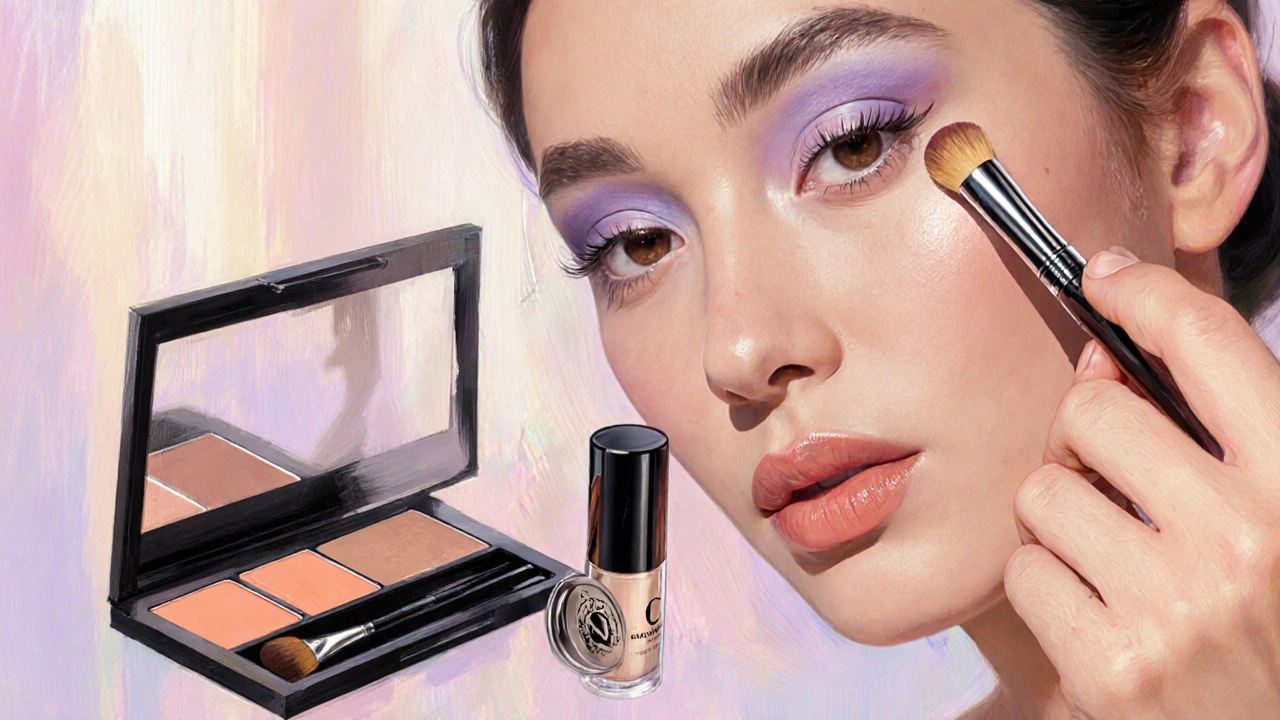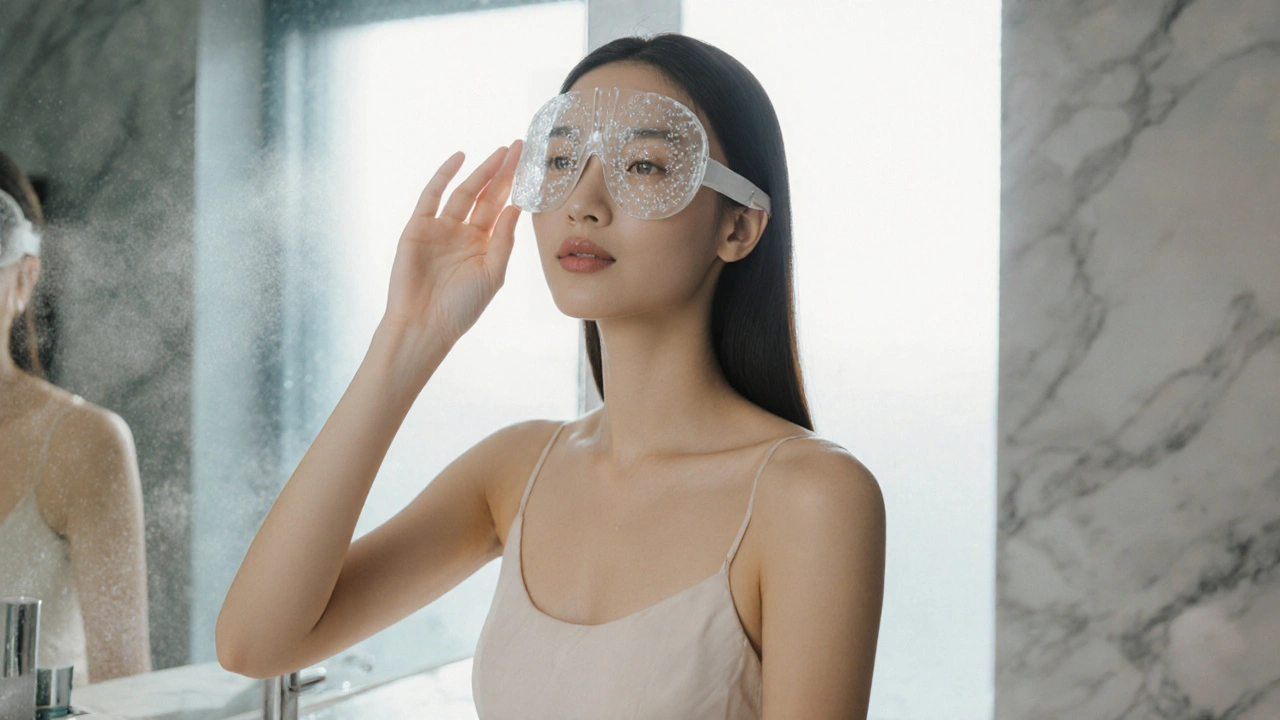Got a morning where your eyes look like they’ve been through a marathon? Whether it’s late‑night binge‑watching, a salty dinner, or just genetics, eye swelling and puffiness can throw off any makeup routine. The good news? With the right prep, a few smart products, and a few tricks from the pros, you can smooth out those tired‑looking lids and still look fresh. Below are the eye swelling makeup tips that actually work, plus a quick‑reference cheat sheet, a side‑by‑side shade guide, and answers to the most common questions.
Quick Takeaways
- Cool compresses (tea bags, cucumber, ice roller) shrink swelling before makeup.
- Use a yellow‑based color corrector that neutralizes purple or red tones before concealer.
- Apply a lightweight eye primer to lock in product and prevent creasing on the lids.
- Set with translucent setting powder to keep everything in place all day.
- Finish with a subtle highlight on the inner corner to lift and brighten.
Why Your Eyes Puff Up (and How to Calm Them)
Before you reach for the brush, it helps to know what’s causing the puff. Fluid buildup, salty foods, allergies, lack of sleep, and even hormonal shifts can all make the skin under your eyes retain water. The skin here is the thinnest on your face, so even a small amount of swelling looks noticeable.
Two quick remedies work for most people:
- Cold therapy. A chill reduces blood flow and lets the lymphatic system drain excess fluid more efficiently.
- Anti‑inflammatory compresses. Green tea, chamomile, or cucumber contain antioxidants that soothe irritated skin.
Give any of these a minute or two before you start applying makeup, and you’ll notice a visible difference.
Step‑by‑Step: From Fresh Face to Flawless Eyes
- Prep with a cool compress. Place chilled tea bags, a frozen gel eye mask, or a sliced cucumber over closed eyes for 30‑60 seconds. Pat dry gently.
- Hydrate your skin. A lightweight eye gel or serum containing hyaluronic acid adds a moisture buffer, preventing the concealer from looking cakey.
- Apply a color corrector. Using a yellow‑based corrector to cancel out the blue‑purple undertones of puffiness, dab a small amount with a synthetic brush. Blend outward, not toward the inner corner.
- Layer a concealer. Choose a creamy concealer that matches your skin tone. Tap it on with a damp picker brush, then blend gently. The corrector underneath ensures the yellow stays hidden.
- Prime the lids. A thin coat of eye primer creates a smooth canvas and stops creasing keeps your eyeshadow from sliding off the puffier area.
- Apply eyeshadow. Stick to matte shades near the lower lash line to avoid drawing attention to any remaining puff. Add a slightly shimmery hue on the mobile lid for a lifted effect.
- Set with powder. Lightly sweep translucent setting powder over the concealer and corrector using a fluffy brush. This locks everything in place for up to 10‑12 hours.
- Highlight the inner corner. A touch of champagne‑toned highlighter on the inner corner and brow bone instantly opens the eye socket.
Choosing the Right Products: A Mini‑Guide
Not all correctors or concealers are created equal. Below is a quick comparison of the most common shade families and the skin tones they neutralize best. Pick the combination that matches the hue of your puffiness (purple, red, or brown) and your natural complexion.
| Corrector Shade | Neutralizes | Best For |
|---|---|---|
| Yellow | Purple/Blue | Fair to medium skin with bluish puffiness |
| Peach | Red/Brown | Medium to deep skin that shows reddish swelling |
| Pink | Dark brown or very deep tones | Deep skin tones with darker puff hues |

Pro‑Level Tricks to Keep Puffiness at Bay All Day
- Layering order matters. Corrector first, then concealer, then primer. This prevents the corrector from getting mixed into the concealer where it would become visible.
- Use a silicone‑based primer. Silicones create a barrier that stops oil from migrating into the delicate eye area, which can cause creasing.
- Swap brushes for sponges. A small, damp makeup sponge can blend corrector and concealer without rubbing away the cool compress’s benefits.
- Set with a mini setting spray. A mist of oil‑free setting spray after powder adds a breathable seal, ideal for humid climates.
- Carry a travel‑size ice roller. A quick roll before a midday meeting can revive the lids without a full‑blown compress.
Common Mistakes (and How to Avoid Them)
Even seasoned makeup lovers slip up sometimes. Here’s what to watch out for:
- Applying too much product. A thin layer of each step is key; building up too quickly leads to a heavy, cakey look.
- Using the wrong corrector shade. Yellow on red‑toned puffiness will make the area look more orange.
- Skipping the setting powder. Without powder, the concealer can slide into wrinkle lines, especially on smile lines.
- Rubbing the skin. Pat, don’t rub. Rubbing pushes product deeper into fine lines and can cause irritation.
Frequently Asked Questions
Can I use regular foundation as a corrector?
Foundation can work in a pinch, but it’s usually too heavy and doesn’t have the right undertone. A dedicated color corrector provides the precise hue needed to neutralize discoloration without adding extra coverage.
How long does the cold compress need to stay on?
Give the eyes 30‑60 seconds of chill. Longer than that can make the skin overly sensitive and cause redness once you start applying products.
Do I need a separate eye primer if I’m already using a full‑face primer?
Yes. The skin around the eyes is thinner and oilier, so a dedicated eye primer ensures the makeup stays put where you need it most.
Is it okay to use a liquid highlighter on puffy lids?
A light dusting of powder or cream highlight works best. Liquid formulas can settle into creases and make puffiness more pronounced.
Can I skip the setting powder if I have oily skin?
Even oily skin benefits from a very thin layer of translucent powder. It locks the concealer in place and prevents the oil from breaking down the product later in the day.
Next Steps: Build Your Anti‑Puff Kit
Now that you know the process, it’s time to assemble a small kit you can stash in your bag:
- Travel‑size gel eye mask or ice roller
- Mini yellow or peach corrector (pick based on your most common puff hue) \n
- Creme concealer that matches your skin tone
- Silicone‑based eye primer (about 0.5oz is enough for a month)
- Translucent setting powder in a compact
- Champagne‑toned highlighter pencil
Keep the kit with you, and each morning you’ll be ready to turn those tired eyes into a fresh‑faced look that lasts. Feel free to experiment with tea bags, cucumber slices, or even a quick splash of cold water-whichever gives you the fastest de‑puff. With the right prep and a few smart makeup moves, swelling won’t stand a chance.
